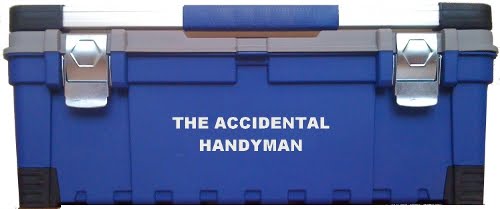 I try to be the most consistent handyman I can be. I also try to be the most consistent blogger I can be. In both, I often try to take on more than I can realistically handle, which leads to mixed results at best.
I try to be the most consistent handyman I can be. I also try to be the most consistent blogger I can be. In both, I often try to take on more than I can realistically handle, which leads to mixed results at best.On the handyman front, those larger projects have been my downfall. So I'm going back to basics and focusing on the small things. Yes, major projects have major impacts, but often, the smaller things can have an equal - or greater - impact.
My new philosophy - which I've been able to stick with for THREE consecutive weekends - is to finish one project each weekend. To date, I've re-fixed the power-flush toilet (which we've decided to pull the plug on, but I'll save that for another day), patched the plethora of nail and screw holes that dot our walls and bolt three bookcases (which were made obsolete by our built-ins) to various wall. All small things that make a small impact.
The project I'm most proud of, however, is re-purposing one of those bookcases into a closet of sorts for my daughter's bedroom. If you've never tried to alter a manufactured bookcase, then you'd probably assume it's easy. While it wasn't a terribly major undertaking, it was a lot more involved than I envisioned.
I am not a furniture maker, nor do I have any knowledge of how furniture is made, so the first thing I had to do was remove the trim from the face of the bookcase to see what I was up against. Starting at the top, from the inside of the shelving unit I tapped the trim until there was a space wide enough to insert a long flat-head screwdriver (a pry bar would have been helpful). Once the trim was off, I saw that the shelves were not only nailed into the frame from the outside, but they were also set in notches in the frame. So much for just pounding away until the shelves either broke or came loose.
Using a nail set, I sunk those outer nails through the frame and into the edges of the shelves. I then removed the staples from the two thin pieces of plywood(?) that make up the back of each shelf and took them off, opening the back of the top two shelves. I then used my hammer to remove the top of the frame. Believe me, this was a great way to work out my frustration with the Patriots, who were in the process of getting shellacked by the Browns.
Once I'd removed the top, I could push the sides of the frame far enough apart to lift out the shelves and reassemble the frame using finish nails. The plywood backing didn't survive removal very well, so the upper half of the unit has no back (which is fine, since we'd painted the interior of the shelves the same gray as our walls). The bare wood of the notches where the two shelves had sat will need to be painted, but for now, I'm ok with them being bare. The various nail holes also need to be filled, but as with the paint, I'm ok with that.
I learned my biggest lesson from re-setting the trim (using the old nails that were still in place). I don't own a rubber mallet, and being the expert hammer-wielder I am, I hit it too hard dinged the trim pretty good in one place. Oh well. That's what wood putty was invented for, right? Luckily, that was the first nail, so for the remainder, I placed a block of 2x4 between the trim and my hammer.
Once I had the unit reassembled, hanging the closet rod was a piece of cake. Ditto for bolting the unit to the wall. Thanks to having a 2-year-old, that's something I could almost do with my eyes closed.
Even before the clothes were hung and toys placed on the bottom shelves, I was damn proud of my work. So was Mrs. Handyman, which made me happy. But the happiest moment was my daughter's reaction upon seeing her new "closet" for the first time: "Oh, that's wonderful."
Because I enjoy it, any opportunity to flex my handyman muscles is a reward in itself. But reactions like that make my work that much more special.
(A note about the photo. At right, you can see one of the salvaged school doors I installed on industrial sliders to use as bedroom doors. Right next to the bookcase is the owl my wife and I made out of paper glued to a canvas for our daughter's first Christmas in 2008. It serves double duty by covering the thermostat.)
-------------------------------
If you're planning to do something similar, here are some tips based on my experience.
- Depending on the size of the bookcase, number of shelves to be removed and your level of experience, plan on this taking about an hour.
- As with any project, figure out what tools and hardware (nails, screws, etc.) you'll need and have them on hand before starting. Once you start, you don't want to be scrambling around (or running to the hardware store). Remember, it's better to have too much than not enough
- Nail set
- Hammer
- Finish nails
- Rubber mallet (or scrap of 2x4)
- Pry bar (or long flat-head screwdriver)
- Adjustable closet rod
- Screwdriver (for installing closet rod)
- Level (for installing closet rod)
- Screwdriver (or power screwdriver/drill with screwdriver bit)
- Wood screws
- Toggle bolts and/or mounting brackets (In case you can't bolt the unit to a stud)

